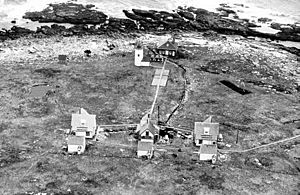Great Duck Island Light facts for kids
 |
|
| US Coast Guard photo | |
|
|
|
| Location | Great Duck Island, Maine |
|---|---|
| Coordinates | 44°8′31.129″N 68°14′44.947″W / 44.14198028°N 68.24581861°W |
| Year first constructed | 1890 |
| Automated | 1986 |
| Foundation | Timber and stone |
| Construction | Brick and granite |
| Tower shape | Cylindrical |
| Markings / pattern | White with black lantern |
| Focal height | 67 feet (20 m) |
| Original lens | 5th order Fresnel lens |
| Current lens | VRB-25 |
| Range | 19 nautical miles (35 km; 22 mi) |
| Characteristic | Fl R 5s |
| Fog signal | HORN: 1 every 15s operates continuously |
| Admiralty number | J0052 |
| ARLHS number | USA-347 |
| USCG number | 1-2295 |
The Great Duck Island Light is a famous lighthouse located on Great Duck Island in Frenchboro, Maine, USA. It was built in 1890. This lighthouse helps ships find their way safely. It marks the entrance to Blue Hill Bay. It also guides ships approaching Mount Desert Island on the central coast of Maine.
The Great Duck Island Light was added to the National Register of Historic Places on March 14, 1988. It is still an active aid for navigation. This means it helps ships know where they are. The United States Coast Guard maintains the light. The land around the lighthouse is owned by the College of the Atlantic. They use it for a special research station.
Contents
About Great Duck Island Light
Great Duck Island is a small island. It is about 237 acres (96 ha) in size. The island is located in the Gulf of Maine. It is about 9 miles (14 km) south of Mount Desert Island. The lighthouse property covers about 11 acres (4.5 ha) at the island's southern tip.
The lighthouse station has five main buildings. These include the tower, the keeper's house, the fog signal house, an oil house, and a small shed. Many more buildings were once here.
The Lighthouse Tower
The lighthouse tower was built in 1890. It is a round brick building. It stands 35 feet 6 inches (10.82 m) tall. A workroom is attached to the tower. The top of the tower has a circular iron railing. This railing surrounds the ten-sided lantern house. The workroom has a sloped roof and extends to the west.
Other Buildings at the Station
Just south of the tower is the fog signal building. It is a square brick building with a sloped roof. It was also built in 1890. A small brick oil house stands to the east of the tower. This building was used to store oil for the light.
The keeper's house is located towards the northern part of the property. It was built in 1890. This house is made of wood. It has two stories and a sloped roof with windows sticking out. It is the only keeper's house that remains. A small shed, also from 1890, stands northeast of the house.
History of the Lighthouse
The Great Duck Island Light station was built in 1890. At this time, Mount Desert Island was becoming a very popular place for vacations. The light first used a "fifth-order lens." This type of lens makes the light brighter and more focused. In 1902, it was replaced with a "fourth-order lens."
The lighthouse became "automated" in 1986. This means machines took over its operation. Before automation, people called "keepers" lived and worked at the lighthouse. The fog signal used to run on steam and coal. There were special buildings for the engine, coal, and collecting rainwater. The Coast Guard removed these buildings when the station became automated.
Research and Conservation
Most of Great Duck Island was bought in 1984. It was purchased by the state of Maine and a group called the Nature Conservancy. In 1997, the lighthouse property was bought by the College of the Atlantic.
The college set up the Alice Eno Field Research Station here. This station studies the large number of birds that live on the island. Student researchers use the old keeper's house as a place to live while they work.


